10 Famous Pop Art Paintings of Modern Art
Many of us associate the Pop art style with cinematography rather than accidentally. Below we will present 10 Famous Pop Art Paintings of Modern Art to convince you of their beauty and uniqueness. In the 20th century, there was a popular artistic movement called "pop art." This movement is often associated with consumerism, mass media, and popular culture. Pop art is focused on using bright colors, clean lines, and an iconic object as its main subject. Artists like to use bright colors because they help make their pictures more exciting. Well, Pop Art is a type of art that was created in the 1950s and 1960s. This contemporary "cool" vibe helped highlight current society's aspects and connect commercial and artistic art. Various sources inspired pop icons, including advertisements, product packaging, pop stars, movie stars, and comic books. Bright colors are intentionally used to attract, which is a clever strategy. Hence, it is more complicated than it appears to be. Thus, we'll discuss what pop art is, how it came to be, who the significant figures are, and the complicated side of the vivid colors.
1. Campbell's Soup Cans by Andy Warhol (1962)
Surely you are wondering why some jars would serve as an art subject. Possibly, the first impression when you see this piece of art is very ambiguous. Well, the answer to this question may surprise you. When Warhol was asked why he painted Campbell's soup cans, the answer was that he painted them because he had the same lunch every day for twenty years. Critics subvert the idea of illustration as a medium of ingenuity and originality as this piece uses a combination of different techniques to create thirty-two canvases, one for each variety of Campbell's soup that was then available.
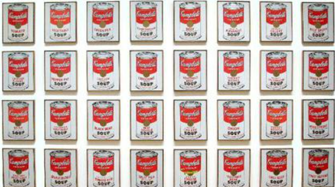
2. Drowning Girl by Roy Lichtenstein (1963)
The used colors and the mimicry of the character in this work of art suggests a message of hopelessness and sadness. Even in this way, it manages to seduce a large audience. The picture, dubbed a "masterpiece of melodrama" is one of the artist's earliest representations of women in unhappy situations. The story emphasizes the excessive melodrama, and Lichtenstein's idea of artistic creation that imitates mechanical replication is illustrated through the visuals, which include Ben-Day dots that represent the printing process. It depicts a woman on a stormy sea with tears in her eyes. She seems to be experiencing mental distress about a relationship. This topic frequently appeared for the artist starting in the mid-1960s.
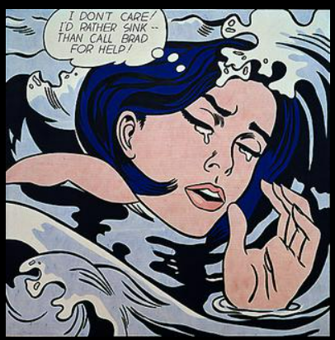
3. Oh, Jeff...I Love You, Too...But…(1964)
The following work of art has an enormous capacity to arouse curiosity. As soon as you look at it, many questions appear in your mind, thanks to the style used, the enlarged face, and the facial expressions. In this work, an adolescent girl and her boyfriend, Jeff, are talking on the phone, but their relationship is in danger from an unknown outside force. Lichtenstein created the subject of this painting and many of his other works by duplicating and altering individual comic book pages. This scenario comes from the Girls' Romances and Hidden Hearts series from DC Comics. The artist has altered several of the painting's components to improve its aesthetic appeal. They have employed vivid colors, strong outlines, and "benday dots" in commercial printing. As a result, the painting resembles a cartoon rather than a realistic image. Every line in the artwork is diagonal, which gives it a feeling of motion and direction. It is hinted that a line runs from the woman's eyes to the bottom left corner. Because the text bubble's letters are also constructed from diagonal lines, they have a different personality. The sad stories of his subjects make his paintings very popular in art and museums.
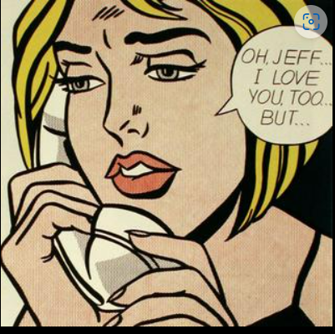
4. Andy Warhol - Marilyn Monroe, 1962
When you think of the pop Art style, the first thing that comes to you is Marilyn Monroe, the protagonist of numerous famous portraits. Andy Warhol created a series of paintings of Marilyn Monroe in 1962 using a still from her 1953 film, Niagara. His paintings had a significant impact because they combined the themes of fame and mortality. However, we will speak about his 1964 painting, Shot Marilyn, which features Marilyn stacked against a wall with different colors and shades. A friend of one of Warhol's photographers, Dorothy Podber, approached him at this time and asked him to "shoot" the artwork. Warhol accepted and thought she was joking around, but she took out a gun and shot all four paintings, turning them into the Shot Marilyns. Warhol thought she was referring to taking pictures of the people when she said "shoot," and he agreed. But Podber pulled out a gun from her bag and fired the paintings. All four paintings, known as The Shot Marilyns, were hit by the bullet at the time.
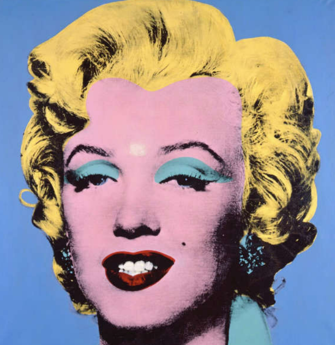
5. Roy Lichtenstein - M-Maybe (A Girl's Picture), 1965
Such a painting will greatly decorate any space. Its sophisticated and charismatic appearance can be a gleaming and captivating decorative accent. Roy Lichtenstein often used action and teen comics as the basis for his writings. In one painting, M-Maybe, a beautiful blonde woman anxiously looks forward to seeing a man who is paramount to her. She says, "M-Maybe he became ill and couldn't leave the studio," but it's clear he was not ill and had already forgotten about her. This painting was created in 1965, the same year it was sold. The cost of Lichtenstein's artworks was increasing, worth several thousand dollars. And this aspect can be justified by their appearance of mechanical and stiff, which is challenging to achieve.
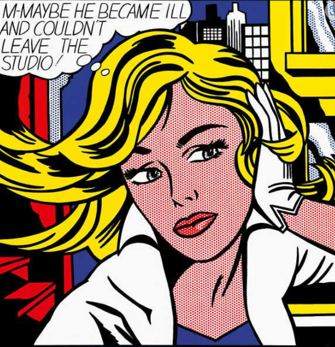
6. Jasper Johns, Three Flags (1958), oil on canvas. Whitney Museum of American Art
When you look at this work of art, the first query that comes to your mind is why the artist has drawn three flags and what his role is. But here, the answer can surprise you, namely by the fact that Johns wanted to explore the boundary between abstraction and representation, and by doing so, he said that he could go beyond the meaning of the flags themselves. In 1954, Jasper Johns created a painting of three American flags. The author uses a combination of colors suspended in warm wax that solidifies as each stroke is made and draws attention to the painting's creation process, resulting in a sensual, almost sculptural surface from accumulating distinct markings. The flags are arranged in a way that makes them look smaller than they are, and Johns makes the flags look like they're floating in space. It sounds bizarre, but it is a new perspective on reality in art.
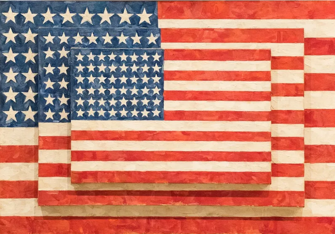
7. Roy Lichtenstein, “Foot and Hand” (1964)
In art, as in life, everything evolves; it changes. This artistic trend has become increasingly popular in the creativity arena to parody certain aspects of life and, not least, to capture the mood of the day. Another American Pop artist with renowned fame is Roy Lichtenstein. Comic books were his primary source of inspiration for his early work. Comic books have a significant influence on his distinctive style, which is distinguished by bold edges and bright colors. Ben-Day dots are a recurring motif throughout Lichtenstein's paintings and sculptures, and he continued to reference this comic book aesthetic in succeeding series.
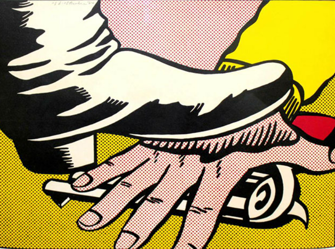
8. Evelyne Axell, “La directrice aux fruits,” 1972
As you can see, Pop Art can have another appeal, much more romantic, calm, and expressive due to the shadows and accents used. Although many female Pop artists were influential throughout their careers, they are frequently left out of the movement's historical narrative. Rosalyn Drexler, a playwright and avant-garde artist; Marisol, a conceptual and Pop artist; and Evelyne Axell, a Belgian painter, contributed significantly to the Pop movement's development. These trailblazers paved the way for more female Pop artists to appear in museum exhibits and auctions today.
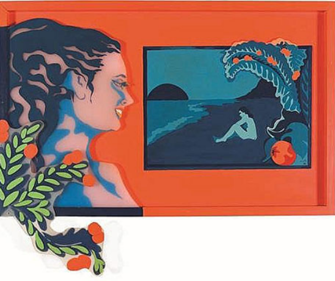
9. Look Mickey (Roy Lichtenstein) (1961)
This illustration leads us to our favorite childhood cartoons having a colossal ability to bring our smile to our lips and raise our mood even on a rainy day. Roy Lichtenstein took inspiration for his 1961 oil on canvas painting Look Mickey from a page of the Walt Disney picture book Donald Duck: Lost and Found. Donald is excited to have caught a massive fish in the painting, and Mickey chuckles covertly. Just the top of the duck's garment has been able to grab his tail. It illustrates Lichtenstein's appropriation of his Pop art based on current popular culture.
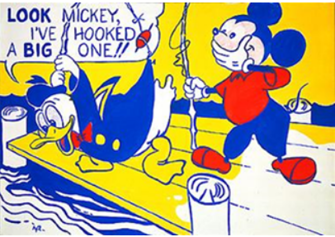
10. Radiant Baby (1990) Keith Haring
Another example of this stylistic trend is the famous work of art, "Radiant Baby," which was realized in 1990 by Keith Haring and featured a crawling baby. As you can see, the newborn is surrounded by light, as shown by the black rays that extend outward. The bright colors and simple outlines make it easy to understand. The newborn baby is considered the most innocent and most positive experience of human existence; the author often uses this symbol in his works.

Pop Art Cartoon

Comments